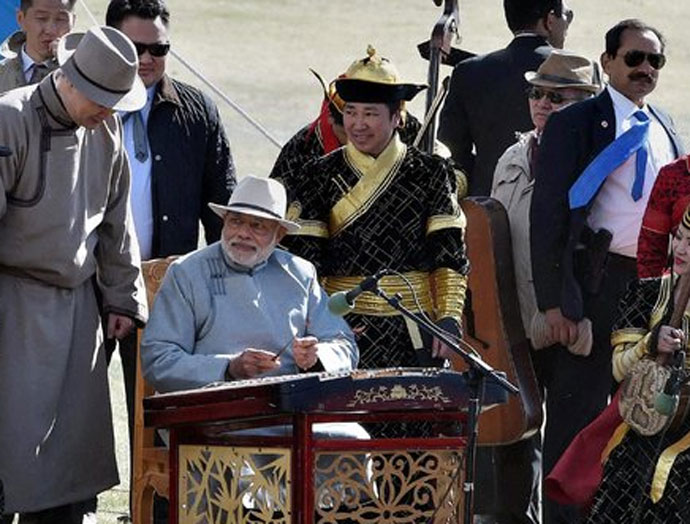How Modi helped raise India's international profile in 2016

In 2016, under Prime Minister Narendra Modi, India continued to enlarge its foreign policy options and generally pursue the goal of raising the country's international profile.
Over the year India exhibited more self-confidence in dealing with challenges, showed more assertiveness in defending its interests, and displayed far more flexibility in exploring compromises on issues of global concern.
Diplomacy
The consolidation of the India-US relationship continued in 2016. Modi met Barack Obama five times during the year. The invitation in June to address the US Congress signified growing bi-partisan support for the India-US relationship.
Modi worked constructively with the US on climate change negotiations, leading to the Paris Agreement. Defence ties with the US continued to expand, with additional equipment orders, the signing of the awkwardly named Logistics Exchange Memorandum of Agreement and India's designation as a Major Defence Partner of the US.
India's push for membership of the Nuclear Suppliers Group (NSG) in 2016 led by Modi himself failed because of China's opposition and lack of adequate US effort in a body founded by it in response to India's 1974 nuclear explosion.
India, however, obtained membership of the Missile Technology Control Group during the year.
In 2016, India continued to grapple with the difficulty of finding a balance between dealing with China as a security threat and as an economic partner. Modi engaged Chinese president Xi Jinping three times in 2016 - at the SCO, G-20 and BRICS summits.
 |
| PM Modi dressed in a traiditional attire plays drums in Mongolia. |
Despite this, the atmosphere of India-China relations deteriorated. The China-Pakistan Economic Corridor, China's persistent opposition to India's NSG membership and blocking the designation of Masood Azhar of the Jaish-e- Mohammed (JeM) as an international terrorist by the relevant UN Security Council Committee hardened negative perceptions in India about China.
As part of this dynamic, India disregarded China's position on maritime issues in the South China Sea and in joint statements with the US, Japan, Vietnam and Indonesia underlined the need to show utmost respect to UNCLOS in addressing them.
To increase its political space in dealing with China, India allowed the Karmapa to visit Tawang in November and, earlier, the US ambassador in Delhi in October. The Dalai Lama's planned visit to Arunachal Pradesh in March 2017 was announced. The invitation to him to attend a Rashtrapati Bhawan event this month was a signal to China that it should not expect only one side to show sensitivity to the core concerns of the other.
At the same time, the economic engagement of China continued with growth in Chinese investments in the country.
Terrorism
With Pakistan relations acquired a new confrontational edge in 2016 with Islamabad-sponsored terrorist attacks against the Pathankot airbase in January and against Army units in Uri (September) and Nagrota (November). Following the killing of Burhan Wani in July, Pakistan chose to fuel disturbances in J&K, with Nawaz Sharif lauding him as a martyr and fulminating against India at the UNGA.
 |
| PM Modi (left) with Pakistan PM Nawaz Sharif in Lahore. (Reuters photo) |
India decided to create more space for itself by changing the nature of its traditional response to Pakistani provocations. Modi alluded to the Baloch issue in his Independence Day speech, which was unprecedented. He created another point of pressure by announcing our intention to exercise India's full rights under the Indus Waters Treaty.
The publicly announced "surgical strikes" by India across the LoC in response to the Uri attack was intended to upset Pakistani calculations about past Indian reactions to such provocations.
India's effort to isolate Pakistan diplomatically on terrorism made some progress with SAARC countries following our lead not to attend the SAARC summit in Islamabad in November. It gained more momentum at the Amritsar Heart of Asia conference on Afghanistan in December, especially with Afghan President Ashraf Ghani's public diatribe against Pakistan on its terrorist affiliations.
India's understandings with key Gulf countries on the terrorism menace - which indirectly put pressure on Pakistan on the issue - was bolstered in 2016.
Geopolitics
As part of carving out geopolitical options to our west, Modi visited Iran in May 2016 and signed the tripartite India-Iran-Afghanistan Chabahar port agreement. The presidents of Tajikistan and Kyrgyzstan visited India in December, with concerns about terrorism and extremism high on the agenda.
Egypt's intrinsic importance in the Arab world, as well as mounting regional concerns about the ideology represented by the Islamic State, made Egyptian President Al Sisi's visit to India in September opportune.
Towards the east, India-Japan strategic ties received a boost with the signing of the civil nuclear agreement between the two countries during the Modi-Abe summit in November. Modi's visit to Vietnam in September had evident geopolitical importance.
Following the India-Africa summit in New Delhi in 2015 Modi's visit to South Africa, Mozambique, Tanzania and Kenya in July kept the momentum of our Africa policy alive. The India-Russia summit in October addressed the perceived drift in Delhi-Moscow ties.
Major defence and energy-related agreements were announced.
However, aspects of Russian policies towards Pakistan and Afghanistan raised concerns during 2016. Russia held military exercises with Pakistan in September. Its statements gave legitimacy to the Taliban as a political force; it initiated a trilateral dialogue with China and Pakistan on Afghanistan.
China's deepening support for Pakistan, coupled with Russia's overtures to it, began a shuffling of the geopolitical cards in the region to our disadvantage.
In summary, 2016 saw India pursuing a more vigorous diplomacy, with considerable success but some less satisfactory results.
(Courtesy of Mail Today.)
Watch:

